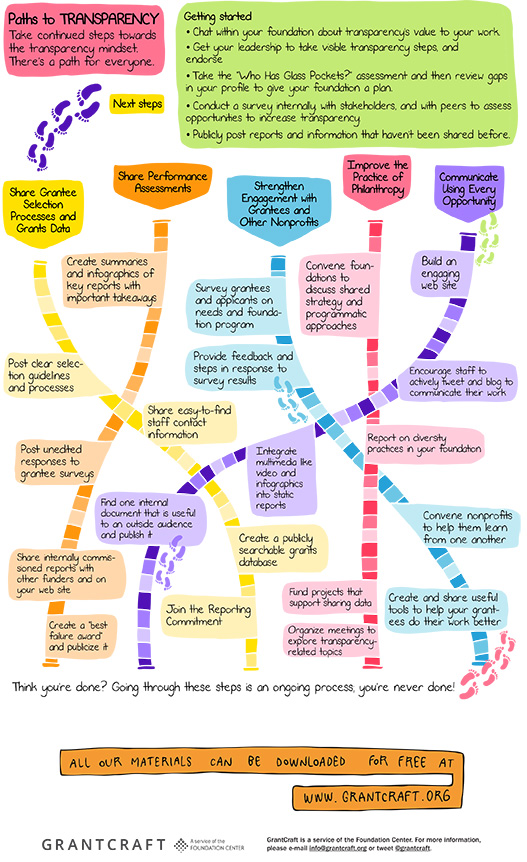Opening Up Demystifying Funder Transparency
Opening Up: Demystifying Funder Transparency explores how transparency can strengthen credibility, improve grantee relationships, facilitate greater collaboration, increase public trust, reduce duplication of effort, and build communities of shared learning. We organized the content into five topical chapters so that you can focus on exploring one approach to transparency at a time.
Listen to our Transparency Chat podcasts, which elaborate on themes explored in the guide using the spoken wisdom of funders from around the globe; read, print, and share our infographic about taking steps towards greater transparency; and review our GrantCraft community survey results. Additionally, if you would like to share your experiences with transparency through a guest blog post, let us know.
Discuss the themes in these resources using #transparency.
This guide and related content were supported by a grant from the Carnegie Corporation of New York and were produced in collaboration with Glasspockets.
What's in the Guide?
- Introduction: What is transparency, and why is it important?
- Behind Closed Doors: Sharing Grantee Selection Processes and Grantee Data: Opening up about selection processes is an important first step towards transparency.
- Is the Needle Moving? Sharing Performance Assessments: Learn about how sharing assessments promotes trusts, increases credibility, and helps to improve learning.
- Improving Relationships: Strengthening Engagement with Grantees and Other Nonprofits: Transparency is a tool to improve relationships, which can strengthen the overall impact of funders' work and the nonprofits they support.
- Peers Helping Peers: Improving the Practice of Philanthropy: When foundation staff are transparent in sharing their goals, lessons learned, and challenges with colleagues, they increase philanthropy’s overall impact.
- Window of Technology: Communicating Using Every Opportunity: Examples of how various communications outlets and strategies can further a funder's transparency efforts.
- Conclusion: We tie together themes throughout the guide and give you steps for moving forward.

Categories
Content type
-
Link to Transparency Tools
Foundations band together to develop shared approach to advocacy evaluation
A common complaint among nonprofit organizations is that foundations pursuing similar objectives require dramatically different metrics and reporting requirements. To address this issue, healthcare foundations in Kansas and Missouri created the Advocacy Evaluation Learning Initiative in 2010, which brought together six funders, 13 high performing advocacy organizations, four local evaluators and two national technical assistance firms.
Read more -
Link to Transparency Tools
“Appropriate” Transparency
Foundations do not, in fact, have to share everything to be transparent. Several foundation leaders have spoken about “appropriate” transparency, which helps better meet both the mission and obligation of a foundation. These leaders reminded us that certain aspects of foundation work don’t need to be open and accessible, because privacy will enable better work and efficiency.
Read more -
Link to Transparency Tools
A Website with the Premise that “Everything Should be Posted”
In 2003, the Meyer Memorial Trust in Portland, Oregon adopted a set of organizational values that included being “open, accessible, and transparent.” At the same time, the trust was undertaking a complete redesign of its website.
Read more -
Link to Transparency Tools
Foundation Collaboration Peers Helping Peers - Improving the Practice of Philanthropy
1. Transparency and Technology
Read more
One project where funders are coming together to connect and learn from each other is Markets for Good. -
Link to Transparency Tools
Being Transparent about Failure "Best Failure" Awards
The King Baudouin Foundation in Brussels, Belgium, embraced the idea of internal learning by launching a “best failure” award within the foundation. The idea behind the award was that learning is much more constructive and richer when people can learn from failures or projects that did not go as expected. Staff from each of the foundation’s 10 activity fields were invited to submit at least one project for the best failure award.
Read more -
Link to Transparency Tools
Transparency Tools
- Grantee Perception Report - Center for Effective Philanthropy
- Tools and Resources for Assessing Social Impact Database - Foundation Center
-
Link to Transparency Tools
Benefits and Challenges of Transparency
1. Behind Closed Doors: Sharing Grantee Data & Processes
Read more -
Link to Transparency Tools
Behind Closed Doors Sharing Grantee Selection Processes and Grantee Data
For many foundations, a first step to becoming more transparent is to share information about their goals, theories of change, and processes for grantee applications. Making grantee selection processes more clear addresses a top complaint from nonprofits: they are frustrated in their efforts to obtain information about a funder’s grant strategies and selection processes, which is integral to developing productive relationships and writing meaningful proposals.
Read more -
Link to Transparency Tools
Why Should Foundations Be More Transparent?
Transparency is not simply a nice idea. Transparency can help foundations build and strengthen relationships that can ultimately help them make a bigger and stronger impact. Funders across the world also face increasing demand by the nonprofit sector, the public, and others to be more open about how they do their work, their decision-making processes, and what they are learning.
Read more -
Link to Transparency Tools
Definition – Foundation Transparency
Transparency is, in a word, openness. A foundation that operates transparently is one that shares what it does, how it does it, and the difference that it makes in a frank, easily accessible, and timely way. True transparency comes down to a mindset, one in which funders believe they are most effective when they approach all aspects of their work by saying “let’s publicly share this.” But transparency is not just about sharing information and processes. It is also a means to greater accountability, and to building relationships between a foundation and other key groups such as grantees, applicants, partners, and other funders.
Read more
Opening Up: Demystifying Funder Transparency explores how transparency can strengthen credibility, improve grantee relationships, facilitate greater collaboration, increase public trust, reduce duplication of effort, and build communities of shared learning. We organized the content into five topical chapters so that you can focus on exploring one approach to transparency at a time.
Listen to our Transparency Chat podcasts, which elaborate on themes explored in the guide using the spoken wisdom of funders from around the globe; read, print, and share our infographic about taking steps towards greater transparency; and review our GrantCraft community survey results. Additionally, if you would like to share your experiences with transparency through a guest blog post, let us know.
Discuss the themes in these resources using #transparency.
This guide and related content were supported by a grant from the Carnegie Corporation of New York and were produced in collaboration with Glasspockets.
What's in the Guide?
- Introduction: What is transparency, and why is it important?
- Behind Closed Doors: Sharing Grantee Selection Processes and Grantee Data: Opening up about selection processes is an important first step towards transparency.
- Is the Needle Moving? Sharing Performance Assessments: Learn about how sharing assessments promotes trusts, increases credibility, and helps to improve learning.
- Improving Relationships: Strengthening Engagement with Grantees and Other Nonprofits: Transparency is a tool to improve relationships, which can strengthen the overall impact of funders' work and the nonprofits they support.
- Peers Helping Peers: Improving the Practice of Philanthropy: When foundation staff are transparent in sharing their goals, lessons learned, and challenges with colleagues, they increase philanthropy’s overall impact.
- Window of Technology: Communicating Using Every Opportunity: Examples of how various communications outlets and strategies can further a funder's transparency efforts.
- Conclusion: We tie together themes throughout the guide and give you steps for moving forward.


